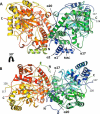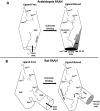Structural analysis of a plant fatty acid amide hydrolase provides insights into the evolutionary diversity of bioactive acylethanolamides
- PMID: 30894416
- PMCID: PMC6509493
- DOI: 10.1074/jbc.RA118.006672
Structural analysis of a plant fatty acid amide hydrolase provides insights into the evolutionary diversity of bioactive acylethanolamides
Abstract
N-Acylethanolamines (NAEs) are fatty acid derivatives that in animal systems include the well-known bioactive metabolites of the endocannabinoid signaling pathway. Plants use NAE signaling as well, and these bioactive molecules often have oxygenated acyl moieties. Here, we report the three-dimensional crystal structures of the signal-terminating enzyme fatty acid amide hydrolase (FAAH) from Arabidopsis in its apo and ligand-bound forms at 2.1- and 3.2-Å resolutions, respectively. This plant FAAH structure revealed features distinct from those of the only other available FAAH structure (rat). The structures disclosed that although catalytic residues are conserved with the mammalian enzyme, AtFAAH has a more open substrate-binding pocket that is partially lined with polar residues. Fundamental differences in the organization of the membrane-binding "cap" and the membrane access channel also were evident. In accordance with the observed structural features of the substrate-binding pocket, kinetic analysis showed that AtFAAH efficiently uses both unsubstituted and oxygenated acylethanolamides as substrates. Moreover, comparison of the apo and ligand-bound AtFAAH structures identified three discrete sets of conformational changes that accompany ligand binding, suggesting a unique "squeeze and lock" substrate-binding mechanism. Using molecular dynamics simulations, we evaluated these conformational changes further and noted a partial unfolding of a random-coil helix within the region 531-537 in the apo structure but not in the ligand-bound form, indicating that this region likely confers plasticity to the substrate-binding pocket. We conclude that the structural divergence in bioactive acylethanolamides in plants is reflected in part in the structural and functional properties of plant FAAHs.
Keywords: Arabidopsis; N-acylethanolamines; crystal structure; endocannabinoid; fatty acid amide hydrolase (FAAH); hydrolase; lipid signaling; oxylipins; quorum sensing; seed germination; squeeze and lock mechanism.
© 2019 Aziz et al.
Conflict of interest statement
The authors declare that they have no conflicts of interest with the contents of this article
Figures











Similar articles
-
Manipulation of Arabidopsis fatty acid amide hydrolase expression modifies plant growth and sensitivity to N-acylethanolamines.Proc Natl Acad Sci U S A. 2006 Aug 8;103(32):12197-202. doi: 10.1073/pnas.0603571103. Epub 2006 Jul 31. Proc Natl Acad Sci U S A. 2006. PMID: 16880402 Free PMC article.
-
Mutations in Arabidopsis fatty acid amide hydrolase reveal that catalytic activity influences growth but not sensitivity to abscisic acid or pathogens.J Biol Chem. 2009 Dec 4;284(49):34065-74. doi: 10.1074/jbc.M109.059022. Epub 2009 Sep 30. J Biol Chem. 2009. PMID: 19801664 Free PMC article.
-
Analysis of fatty acid amide hydrolase activity in plants.Methods Mol Biol. 2013;1009:115-27. doi: 10.1007/978-1-62703-401-2_12. Methods Mol Biol. 2013. PMID: 23681529
-
Fatty Acid Amide Hydrolases: An Expanded Capacity for Chemical Communication?Trends Plant Sci. 2020 Mar;25(3):236-249. doi: 10.1016/j.tplants.2019.11.002. Epub 2020 Jan 7. Trends Plant Sci. 2020. PMID: 31919033 Review.
-
The N-acylethanolamine-mediated regulatory pathway in plants.Chem Biodivers. 2007 Aug;4(8):1933-55. doi: 10.1002/cbdv.200790161. Chem Biodivers. 2007. PMID: 17712835 Review.
Cited by
-
Plant N-acylethanolamines play a crucial role in defense and its variation in response to elevated CO2 and temperature in tomato.Hortic Res. 2022 Oct 26;10(1):uhac242. doi: 10.1093/hr/uhac242. eCollection 2023 Jan. Hortic Res. 2022. PMID: 37077371 Free PMC article.
-
Lipophilic signals lead to organ-specific gene expression changes in Arabidopsis seedlings.Plant Direct. 2020 Jul 15;4(7):e00242. doi: 10.1002/pld3.242. eCollection 2020 Jul. Plant Direct. 2020. PMID: 32775951 Free PMC article.
-
Enhanced seedling growth by 3-n-pentadecylphenolethanolamide is mediated by fatty acid amide hydrolases in upland cotton (Gossypium hirsutum L.).Plant Direct. 2022 Jul 12;6(7):e421. doi: 10.1002/pld3.421. eCollection 2022 Jul. Plant Direct. 2022. PMID: 35844778 Free PMC article.
-
Beyond the Usual Suspects: Physiological Roles of the Arabidopsis Amidase Signature (AS) Superfamily Members in Plant Growth Processes and Stress Responses.Biomolecules. 2021 Aug 13;11(8):1207. doi: 10.3390/biom11081207. Biomolecules. 2021. PMID: 34439873 Free PMC article. Review.
-
Fatty acid amide hydrolase and 9-lipoxygenase modulate cotton seedling growth by ethanolamide oxylipin levels.Plant Physiol. 2023 Feb 12;191(2):1234-1253. doi: 10.1093/plphys/kiac556. Plant Physiol. 2023. PMID: 36472510 Free PMC article.
References
-
- Keereetaweep J., Blancaflor E. B., Hornung E., Feussner I., and Chapman K. D. (2015) Lipoxygenase-derived 9-hydro(pero)xides of linoleoylethanolamide interact with ABA signaling to arrest root development during Arabidopsis seedling establishment. Plant J. 82, 315–327 10.1111/tpj.12821 - DOI - PubMed
Publication types
MeSH terms
Substances
Associated data
- Actions
- Actions
- Actions
- Actions
- Actions
- Actions
- Actions
- Actions
- Actions
Grants and funding
LinkOut - more resources
Full Text Sources
Molecular Biology Databases
Miscellaneous

